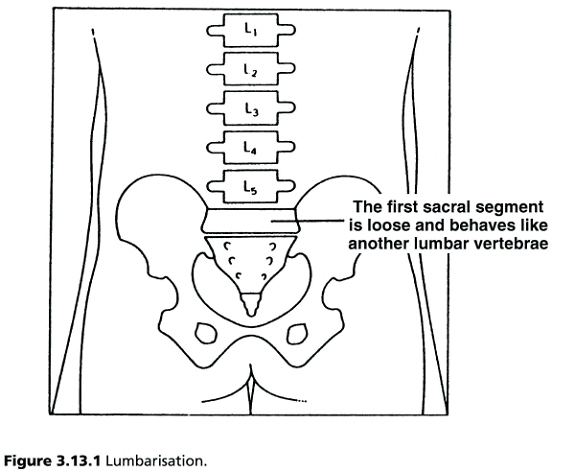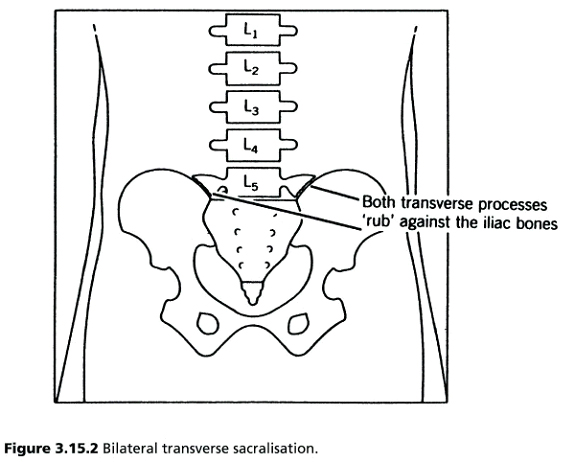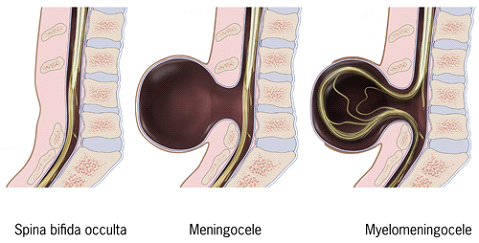Congenital abnormalities also known as birth defects, they are a functional or structural condition existing at or before birth. The cause and symptoms of birth defects can vary widely. Although the specific cause of congenital anomalies are not known, they may be a result of environmental or genetic factors, infections or the maternal nutritional status- such as folate deficiency.
Within the spine in particular, there may be a number of disturbances than can affect the formation of the spinal column in the developing foetus. These can lead to deformities that can affect an individual’s everyday life in varying degrees of severity. Malformations to the sacrum are among the most common with varying variations.
Lumbarisation- an extra vertebrae
 Normally, the lumbar vertebrae are lined one below the other, separated by intervertebral discs and the sacral vertebrae are all fused together to form the sacral base. Lumbarisation is where the uppermost segment of the sacrum is not completely fused to the lower sacral components and may be free to move to some degree and participate with its neighbouring lumbar vertebrae. Therefore, the first sacral segment is said to be lumbarised and can sometimes be referred to as an extra vertebrae.
Normally, the lumbar vertebrae are lined one below the other, separated by intervertebral discs and the sacral vertebrae are all fused together to form the sacral base. Lumbarisation is where the uppermost segment of the sacrum is not completely fused to the lower sacral components and may be free to move to some degree and participate with its neighbouring lumbar vertebrae. Therefore, the first sacral segment is said to be lumbarised and can sometimes be referred to as an extra vertebrae.
Although the segment may have some degree of movement, it is rarely ever completely free, therefore, making it more vulnerable to incidental trauma, injury and joint irritation. As you age and increase activity the segment may find it difficult to cope and can become an area that triggers pain and discomfort. Some examples of the symptom complaints that can arise from patients with lumbarisation include back pain, inflammation, swelling, muscle spasm, increased back stiffness and decreased range of motion.
Treatment for lumbarisation depends on the nature of the anomaly and a proper diagnosis of the specific type can be done using imaging studies. However, evidence suggests that conservative care is the an effective form of treatment. This includes; anti-inflammatory medications, cold laser therapy, interferential, dry needling, manual therapies such as mobilisation and manipulation and soft tissue therapy and specific exercises to strengthen and stretch the back muscles. Furthermore, Pilates and core stability exercises have been shown to improve symptoms associated with lumbarisation.
Sacralisation
 When the last lumbar segment (L5) is fused to either the sacral base or the ilium, either uni- or bilaterally it is known as sacralisation. It can be either the L5 vertebral body that is fused to the sacrum which is termed as central sacralisation or only the transverse processes to the ilium termed as transverse sacralisation (uni- or bilateral). Once the vertebrae is fused it functions more as part of the sacral base and therefore, the segment is termed as a sacralised vertebrae.
When the last lumbar segment (L5) is fused to either the sacral base or the ilium, either uni- or bilaterally it is known as sacralisation. It can be either the L5 vertebral body that is fused to the sacrum which is termed as central sacralisation or only the transverse processes to the ilium termed as transverse sacralisation (uni- or bilateral). Once the vertebrae is fused it functions more as part of the sacral base and therefore, the segment is termed as a sacralised vertebrae.
Sacralisation of the lumbar vertebrae can either be symptomatic or asymptomatic and the varying degrees of intensity and severity vary depending on the patients.
When one side of the vertebrae is fused and the other is not it can cause biomechanical problems. It creates imbalances in lower back movements. Muscles and ligaments function differently on one side of your back to the other side therefore creating imbalanced lower back movement. This imbalanced movement leads to pain and inflammation. Chiropractic manipulation may help with some of this movement imbalance by restoring proper function to joints that are under abnormal stress. Various techniques are also used to help reduce lower back inflammation such as dry needling, Photobiomodulation and interferential.
Spina Bifida Occulta
 Spina Bifida Occulta is a group of conditions or a birth defect affecting the development of a baby’s spinal column while in the womb. There are three varying forms of Spina Bifida Occulta and they all differ in degrees of severity.
Spina Bifida Occulta is a group of conditions or a birth defect affecting the development of a baby’s spinal column while in the womb. There are three varying forms of Spina Bifida Occulta and they all differ in degrees of severity.
The mildest form of spina bifida results in no signs or symptoms and experience no neurological problems. However, visible indications can be seen on an infant’s skin above the spinal defect; an abnormal tuft of skin, a collection of fat and/or a dimple or birthmark.
The second form is meningocele which is a rare form, where the protective layer of the spinal cord (meninges) push through an opening in the vertebrae. There is no compromise to the development of the spinal cord, therefore, the membrane can be removed with surgery with no further damage to the nerves and surrounding structure.
The third form Myelomeningocele and the most severe form is also known as “open spina bifida”. In this form the baby’s spinal canal forms on the outside and remains open exposing tissues and nerves making the baby prone to life-threatening infections and neurological impairment is common.
Treatment of Spina Bifida Occulta depends on the severity and form of the condition. A common complaint/symptom for the mild form is persistent low back pain. Evidence suggests that regular stretching exercises and core stability exercises and strengthening of the muscles surrounding the spine may relieve the pain and increase the spines mobility. Hamstring stretches, lower back and hip flexor stretches as well as heel stretches daily have been shown to prevent discomfort. Additionally, an effective piece of equipment used to assist in strengthening of your core muscles is a stability ball or an exercise ball. There are a wide variety of exercises that can be performed using an exercise ball to enhance core strengthening. Furthermore, Pilates has been shown to assist with mobility and strengthening of muscles which may in turn promote pain relief.



